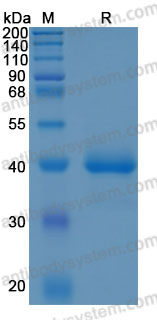Catalog No.
AMD51501
Biological activity
Measured by its ability to chemoattract mouse pro‑B cells (BaF3) transfected with mouse CCR8. The ED50 for this effect is 0.5-2.0 ng/mL.
Expression system
Mammalian Cells
Species
Mus musculus (Mouse)
Protein length
Lys24-Cys92
Nature
Recombinant
Endotoxin level
<0.1 EU/μg of the protein by the LAL method.
Purity
>90% as determined by SDS-PAGE.
Accession
P10146
Applications
Bioactivity, ELISA, Immunogen, SDS-PAGE, WB
Form
Lyophilized
Storage buffer
Lyophilized from a solution in PBS pH 7.4, 5% Trehalose, 5% Mannitol.
Reconstitution
Reconstitute in sterile water for a stock solution. A copy of datasheet will be provided with the products, please refer to it for details.
Shipping
In general, proteins are provided as lyophilized powder/frozen liquid. They are shipped out with dry ice/blue ice unless customers require otherwise.
Stability and Storage
Use a manual defrost freezer and avoid repeated freeze thaw cycles. Store at 2 to 8°C for one week. Store at -20 to -80°C for twelve months from the date of receipt.
Alternative Names
C-C motif chemokine 1, T lymphocyte-secreted protein I-309, Small-inducible cytokine A1, CCL1, SCYA1,
Neuroinflammatory chemokine networks in transgenic models of Alzheimer's disease: A comparative multi-compartmental analysis., PMID:40472196
Efflux of N1-acetylspermidine from hepatoma fosters macrophage-mediated immune suppression to dampen immunotherapeutic efficacy., PMID:40460833
Multi-omics integrated analysis reveals the impact of cytokinin on sex differentiation in industrial hemp., PMID:40376452
Galectin-1-targeted theranostic nanoprobe for multimodal imaging and photothermal therapy in cervical cancer lymph node metastases., PMID:40279817
Inhibition of Alkbh5 Attenuates Lipopolysaccharide-Induced Lung Injury by Promoting Ccl1 m6A and Treg Recruitment., PMID:40254698
Integrated transcriptomic and proteomic profiling reveals the anti-inflammatory mechanism of dihydroartemisinin in the treatment of acute liver injury by targeting CYBA and CYBB., PMID:40250321
CCR8+ decidual regulatory T cells maintain maternal-fetal immune tolerance during early pregnancy., PMID:40249828
Pulsed Radiofrequency Alleviates Acute Soft Tissue Injury in Rats by Regulating the TNF/mTOR Signaling Pathway., PMID:40197902
Macrophage-derived CCL1 targets CCR8 receptor in hepatic stellate cells to promote liver fibrosis through JAk/STAT pathway., PMID:40122149
Interaction between nasal epithelial cells and Tregs in allergic rhinitis responses to allergen via CCL1/CCR8., PMID:40051629
Discovery of CCR8 Antagonist IDOR-1136-5177 for the Treatment of Cancer., PMID:39988468
[Exploration of CCL11 and sTNFR2 as potential biomarkers for the efficacy of lymphocyte immunotherapy in women with unexplained recurrent spontaneous abortion]., PMID:39863550
Urine proteomics defines an immune checkpoint-associated nephritis signature., PMID:39863302
No bones about it: regulatory T cells promote fracture healing., PMID:39817452
Inflammatory Response of THP1 and U937 Cells: The RNAseq Approach., PMID:39768153
Group B Streptococcal Membrane Vesicles Induce Proinflammatory Cytokine Production and Are Sensed in an NLRP3 Inflammasome-Dependent Mechanism in a Human Macrophage-like Cell Line., PMID:39761308
Combination of triciribine and p38 MAPK inhibitor PD169316 enhances the differentiation effect on myeloid leukemia cells., PMID:39739720
Paeoniflorin inhibits APEC-induced inflammation in HD11 cells through the NF-κB signaling pathway by activating CB2R., PMID:39721268
Progranulin-dependent repair function of regulatory T cells drives bone-fracture healing., PMID:39509336
CCR8/CCL1 and CXCR3/CXCL10 axis-mediated memory T-cell activation in patients with recalcitrant drug-induced hypersensitivity., PMID:39503255
Acute and chronic impact of interleukin-33 stimulation on chemokines and growth factors in human cord blood-derived mast cells., PMID:39432538
Neuropsychiatric symptoms in cognitive decline and Alzheimer's disease: biomarker discovery using plasma proteomics., PMID:39288961
Transcription start site scanning requires the fungi-specific hydrophobic loop of Tfb3., PMID:39287137
Cytokine and chemokine profiles in pulmonary tuberculosis with pre-diabetes., PMID:39267759
The chemokine receptor CCR8 is not a high-affinity receptor for the human chemokine CCL18., PMID:39259753
Prognostic Value and Therapeutic Significance of CCL Chemokines in Gastric Cancer., PMID:39129286
Gut-derived memory γδ T17 cells exacerbate sepsis-induced acute lung injury in mice., PMID:39112475
Clonal haematopoiesis is associated with major adverse cardiovascular events in patients with hypertrophic cardiomyopathy., PMID:39091134
Targeting the glucocorticoid receptor-CCR8 axis mediated bone marrow T cell sequestration enhances infiltration of anti-tumor T cells in intracranial cancers., PMID:39044027
Cross-talk between ILC2 and Gata3high Tregs locally constrains adaptive type 2 immunity., PMID:39028828
Cryo-EM Structure and Biochemical Analysis of the Human Chemokine Receptor CCR8., PMID:38985857
Effect of Metformin on systemic chemokine responses during anti-tuberculosis chemotherapy., PMID:38850838
Paeoniflorin protects chicken against APEC-induced acute lung injury by affecting the endocannabinoid system and inhibiting the PI3K/AKT and NF-κB signaling pathways., PMID:38833957
Quantitative and qualitative analysis of stability for 16 serum immunoregulators over 50 freeze-thaw cycles., PMID:38682460
Suberanilohydroxamic acid (SAHA), a HDAC inhibitor, suppresses the effect of Treg cells by targeting the c-Myc/CCL1 pathway in glioma stem cells and improves PD-L1 blockade therapy., PMID:38652401
Immune-Modulating Effects of Low-Carbohydrate Ketogenic Foods in Healthy Canines., PMID:38590952
Inflammatory responses in esophageal mucosa before and after laparoscopic antireflux surgery., PMID:38577078
[Comparative study on the degradation rate and regulatory effects of two resorbable collagen membranes during the in vivo implantation]., PMID:38548593
Antigen-specific chemokine profiles as biomarkers for detecting Mycobacterium tuberculosis infection., PMID:38510248
Reduced chemokine C-C motif ligand 1 expression may negatively regulate colorectal cancer progression at liver metastatic sites., PMID:38506205
The Role of Rv1476 in Regulating Stress Response and Intracellular Survival of Mycobacterium tuberculosis., PMID:38392218
Identification of systemic biomarkers and potential drug targets for age-related macular degeneration., PMID:38361503
Identification of novel human CC chemokine receptor 8 (CCR8) antagonists via the synthesis of naphthalene amide and sulfonamide isosteres., PMID:38354503
Differential cytokine and chemokine expression after ablation vs. resection in colorectal cancer liver metastasis., PMID:38318321
Osteopontin interacts with dendritic cells and macrophages in pulp inflammation: Comprehensive transcriptomic analysis and laboratory investigations., PMID:38279773
High and selective cytotoxicity of ex vivo expanded allogeneic human natural killer cells from peripheral blood against bladder cancer: implications for natural killer cell instillation after transurethral resection of bladder tumor., PMID:38245792
Development of a cellular model to study CCR8 signaling in tumor-infiltrating regulatory T cells., PMID:38231448
The effect of ingested copper on the structural and cytotoxic properties of Steatoda grossa (Theridiidae) spider silk., PMID:38218003
NLRP3 regulates CIITA/MHC II axis and interferon-γ-inducible chemokines in Malassezia globosa-infected keratinocytes., PMID:38214420
Structural basis of antibody inhibition and chemokine activation of the human CC chemokine receptor 8., PMID:38040762

